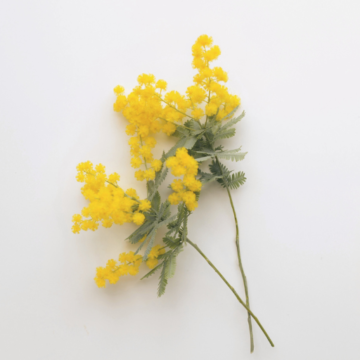When it comes to stunning and captivating flowers, wattle steals the show as one of Australia’s most extraordinary floral treasures. Also known as acacia, wattle is a diverse group of flowering plants belonging to the genus Acacia, boasting over a thousand species. With a vibrant palette of colours, a wide range of shapes and sizes and its roots firmly planted in Australia, these native beauties have captured the hearts of locals and gained popularity worldwide.
Wattle’s history stretches back centuries, with evidence of its use by Aboriginal Australians. Wattle holds a special place in their culture, serving practical and symbolic purposes. The various species of wattle have been used for food, medicine, tools and even as a source of timber. Moreover, wattle symbolises endurance, resilience and the connection to the land.
When it comes to variety, wattle offers an astonishing assortment of options. With over 1,000 species, these flowering plants display a vibrant array of colours, ranging from golden yellows to warm oranges and even pale creams. Each variety has its own unique characteristics, such as leaf shapes, growth habits and flowering patterns. It’s no surprise that wattle enthusiasts claim that somewhere in Australia, a wattle species is blooming somewhere.
Wattle holds a special place in Australian culture, closely associated with national identity and featured prominently in celebrations like Australia Day. The Golden Wattle (Acacia pycnantha) has been officially recognized as Australia’s national floral emblem since 1988. Its bright yellow blossoms symbolise unity, resilience and the spirit of the Australian people.
Beyond cultural significance, wattle carries symbolic meaning, representing new beginnings, hope and renewal.
Aside from their visual appeal, certain wattle species possess medicinal properties. Traditional Indigenous practices have utilised wattle in various remedies, treating skin conditions, coughs and colds. The bark, leaves and flowers contain compounds with antimicrobial, anti-inflammatory and analgesic properties. https://onlinelibrary.wiley.com/doi/pdf/10.1002/ptr.5335
Australia is a major exporter of cut flowers, including wattle. The cultivation process involves carefully selecting suitable species, cultivation in commercial nurseries and adhering to strict quality standards. Wattle is grown across various regions, ensuring a continuous supply for domestic and international markets.

Wattle’s vase life varies depending on the species and environmental conditions. On average, these blooms can last up to two weeks with proper care. To maximise their longevity, follow a few care tips:
- Trim the stems: Before placing wattle in a vase, trim the stems at an angle to enhance water absorption.
- Use clean water: Fill the vase with clean, lukewarm water and change it every two to three days.
- Remove leaves: Remove submerged foliage to prevent bacterial growth and extend the vase life.
- Keep cool: Display wattle in a cool area away from direct sunlight to prevent wilting.
- Scraping back the outer rough bark can help the stems uptake of water.
- Mist the blooms: Lightly mist the flowers to maintain their freshness and prevent dehydration.

The presence of wattle can positively impact mental health and well-being. The vibrant colours and delicate beauty of these blooms evoke feelings of happiness, serenity and optimism. Surrounding yourself with wattle creates a calming and uplifting atmosphere, enhancing relaxation and reducing stress. Whether you place a bouquet of wattle in your living room or spend time in nature where wattle blooms abundantly, the presence of these flowers can have a soothing effect on your mind and overall well-being.
While many wattle species are readily available, some varieties are considered rare and hold significant value. One such example is the Candelabra Wattle (Acacia covenyi), renowned for its stunning candle-like flower clusters. Collectors and enthusiasts eagerly seek out these unique blooms, and their scarcity commands higher prices. https://www.anbg.gov.au/gnp/trainees-2016/acacia-covenyi.html

Here are a few intriguing facts about wattle:
- The tallest recorded wattle tree, an Acacia aneura specimen found in Western Australia, stood an impressive 43 meters (141 feet) tall.
- Wattle has been used as a natural dye for centuries, producing a range of hues from yellows and browns to vibrant oranges.
- Besides their ornamental and cultural significance, certain wattle species play a vital ecological role by providing habitat and food for native animals, including birds, insects and marsupials.
- Wattle seeds are edible and have been used as a food source by Indigenous Australians. They can be ground into a flour or roasted and enjoyed as a snack.
Wattle stands as a testament to Australia’s natural beauty and cultural heritage. With its rich history, diverse varieties and symbolic meanings, wattle continues to enchant flower enthusiasts worldwide. From its healing properties and role in the cut flower industry to its ability to improve mental health and well-being, wattle’s allure goes far beyond its bright appearance.



